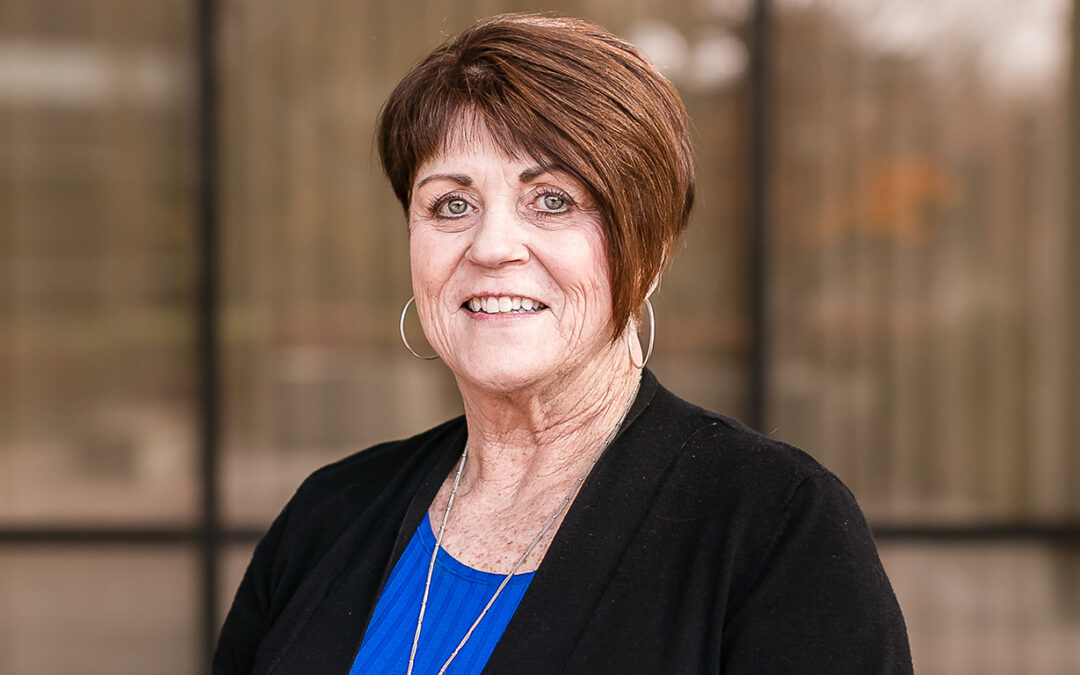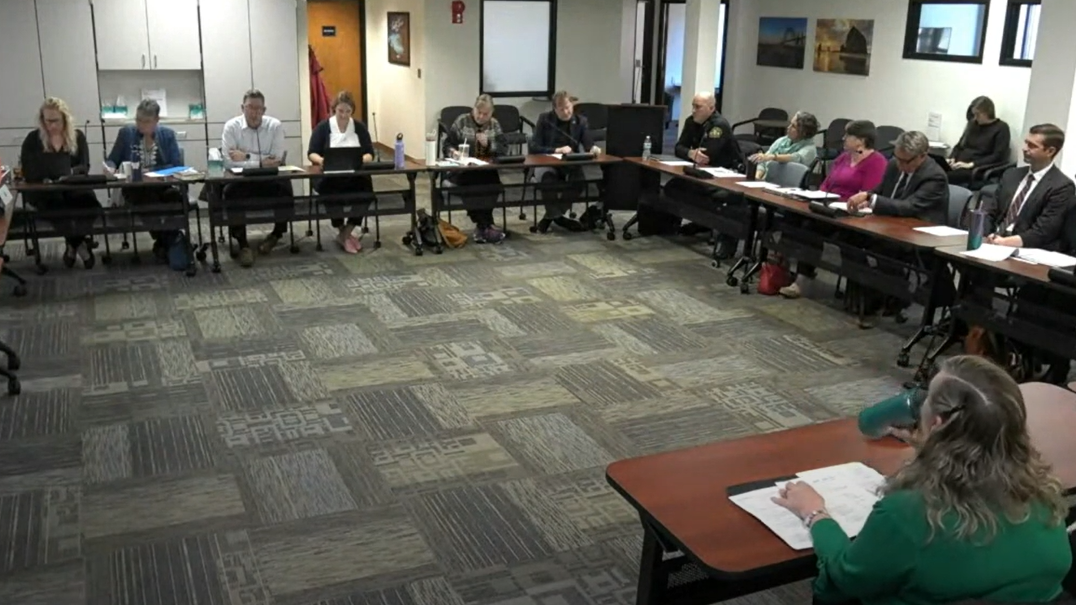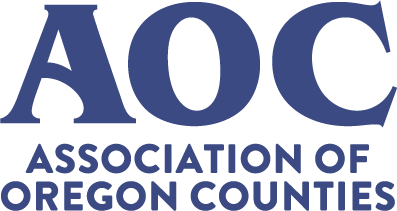
Dec 28, 2023 | AOC News
Integrity. Grace. Humor. These are the traits described by current and former staff about their long-time coworker, Joann Hendrix.
After 30 years of dedicated service to AOC, Joann is retiring at the end of the year. Joann joined AOC in 1994 as a management assistant, supporting the County Road Program and the Oregon Association of County Engineers and Surveyors (OACES), in addition to daily office activities and special projects at AOC.
Former County Road Program Manager Pat Ehrlich was on the hiring team when she joined AOC. According to Ehrlich, she learned fast and routinely anticipated the department’s needs. “She truly helped me do my work more efficiently as she could proceed without lots of direction. She was well respected by those in the counties our program worked with.”
During her tenure at AOC, Joann worked in different capacities at AOC, serving as management assistant for several years, before settling into her most recent position as senior administrative manager focusing on event planning and travel for the organization. In this role, Joann supported a broad array of association activities and events — planning conferences, meetings, special events, and travel for AOC staff, the AOC Board of Directors, and affiliate and associate member organizations. She also worked as the OACES administrative manager overseeing the OACES membership, bookkeeping, budget, and facilitation of all meetings and conferences.
Executive Director Gina Nikkel has had the privilege of working with Joann for the last thirty years as a county commissioner, AOC staff, and now the executive director. “When I came back to AOC as the executive director, I was thrilled that Joann was still here serving our members with professionalism, grace, and dedication,” Nikkel said. “It’s hard to lose a long-term employee that has served AOC so well, and I wish her well in her retirement.”
In all her positions and throughout her career at AOC, she was widely known to be attentive, reliable, and conscientious. Whether it was remembering a guest who preferred hot chocolate over coffee in the morning, or which restaurant in Washington D.C. had the best steak, to leaving small treats for members and staff in their rooms, Joann always made sure everyone was taken care of at events.
“There wasn’t a problem she couldn’t solve. Her vast knowledge of the state, where to stay, where to eat, and renting cars was invaluable,” said former AOC staff member Eric Schmidt. “Getting us back and forth from Washington, D.C. during the forest payment days and getting us to NACo conferences was quite the task and Joann always came through.”
Joann’s favorite aspect of her job was planning meetings and the annual conference. She liked ensuring members were taken care of and having a good time. Staff will miss Joann’s stories from her time with AOC over the years. From the beginning days of product tasting held in various hotel rooms down a hallway at the Red Lion Hotel Pendleton, to the AOC “band” — consisting of county elected officials, county staff, and even some AOC staff – performing once a year during the annual conference, Joann has seen it all.
“AOC has been like a family,” Joann said. “I will miss the camaraderie, teamwork, and the friendships I’ve made over the years.”
In true Joann fashion, she said her retirement plans include “learning how to be retired.” Judging from her past work, she will excel at it just like everything else.
Contributed by: Erin Good | AOC communications coordinator

Dec 21, 2023 | AOC Advocacy, Natural Resources
Oregon set a goal of generating 50% of the total electricity needed for Oregonians through renewable resources by 2040. As a result of this goal, found in the Oregon Renewable Portfolio Standard, wind and solar projects have been increasing across the landscape. In 2020, solar energy generation accounted for approximately 1,077,900 MWh or just shy of 3% of all the electricity generated in Oregon. Wind power makes up 11.6% of the electricity generated in the state (~8,777,254 MWh). With the evolving energy systems, such as bioenergy, geothermal, and hydropower, the demand for energy storage has grown significantly.
Legislative Committee staff invited AOC to participate in a legislative work group, whose intent was to craft language for a bill concept to introduce in the upcoming February session. It was clarified in the work group up front that county commissioners would need to see the final language before taking an official position. However, AOC staff agreed to join the group and provide input where appropriate. In addition to AOC staff, Lake County Commissioner James Williams also participated in the legislative work group.
The work group has met every few weeks since mid-September with the purpose of developing bill language to resolve an issue brought forward by some energy storage clients. Specifically, “energy storage facilities are not formally being reviewed or permitted by EFSC.” Using House Bill 2989-2 (2023) as a starting place, the work group began discussing various aspects of battery energy storage systems. A battery energy storage system is a device that would enable the energy from a renewable project like solar or wind, to be stored and then released later when the power is most needed. The work group discussed where these battery systems could or should be located, as well as how the siting and permitting process works both on a county and state level. After many discussions, the bill concept was narrowed to a few widely agreed-upon areas.
First, a definition of battery energy storage systems was necessary to place in statute. Because the Energy Facility Siting Council (EFSC) statutes were written before this technology was created, a definition is necessary for the EFSC to operate under. Next, a shared desire among some in the work group was the ability for counties to request a review of projects through the EFSC, similar to other energy projects, if that was how the county desired to handle the projects. Finally, there was a belief that a separate site certificate is not required if the battery energy storage system was being requested and would be subject to a site certificate for another energy facility (see language found in ORS 469.320).
The bill concept is currently being drafted in the Office of the Legislative Counsel for the 2024 session. Once draft language is available, the bill concept will be brought to the Natural Resources Steering Committee in January for discussion and consideration.
Contributed by: Branden Pursinger | AOC legislative affairs manager

Dec 21, 2023 | AOC Advocacy, Health & Human Services
Oregon counties will be undertaking critical health and human services policy work and partnership development at the Association of Oregon Counties (AOC) in 2024 along three tracks.
Internally, counties are convening monthly at AOC Health and Human Services summit meetings to share and deliberate on local solutions and to develop legislative priorities for local system improvement for the 2025 legislative session. The next summit meeting is scheduled for Monday, Jan. 22, 1 to 4 p.m., at the AOC headquarters in Salem.
To guide AOC’s legislative advocacy in the 2024 short session, our Health and Human Services Steering Committee will meet January through March on AOC Day at 8 a.m., followed by a joint Health and Human Services and Public Safety Steering Committee meeting from 9 to 11 a.m. A stand-alone Public Safety Steering Committee meeting will begin immediately following the joint meeting.
Legislative concepts with potential impacts to county government and programs slated for consideration in the 2024 session include Ballot Measure 110 reforms, local behavioral health system improvements, behavioral health and community corrections gap funding for services to mandated populations, emergency medical services modernization, treatment courts system stabilization, and jail-based medication assisted treatment for opioid addiction.
The Local Government Advisory Committee for Health and Human Services will resume its regular schedule on the fourth Friday at 10 a.m. on Jan. 26, where we look forward to welcoming the new Oregon Health Authority (OHA) Director Dr. Sejal Hathi and discussing how OHA and counties can partner more closely in 2024 on the development of community services funding proposals and legislative advocacy for system improvement.
Contributed by: Jessica Pratt | AOC legislative affairs manager

Dec 21, 2023 | AOC Advocacy, Governance, Revenue, & Economic Development
The biennial Court Facilities Task Force, a collaboration between AOC and the Oregon Judicial Department (OJD) to evaluate and prioritize courthouse improvements and replacements, kicks off in January. Funding requests for projects recommended by the task force will be included in OJD’s 2025 legislative budget proposal, which must be submitted by April 2024.
County officials, commissioners, judges, or chairs representing counties that may want help with courthouse projects in the next few years are strongly encouraged to participate in the task force process. AOC is also actively seeking volunteers to serve as members of the task force. Please reach out to mburdick@oregoncounties.org if you are interested in serving.
A kickoff meeting will be held on Tuesday, Jan. 2. OJD staff will provide background information about the task force, review the status of projects that were prioritized last cycle, and answer your questions.
AOC-OJD Court Facility Task Force Kickoff Meeting
Tuesday, Jan. 2, 2024, 10 a.m. to 2 p.m.
AOC Hood Conference Room (2nd Floor)
1212 Court St NE, Salem Oregon
Or attend virtually: https://meet.google.com/hhj-yfbd-dtr
Or dial: (US) +1 209-862-8182 PIN: 891 906 660#
Two additional task force meetings are planned:
- Thursday, Feb. 1, 10 a.m. to 2 p.m. | Task force reviews county presentations summarizing their proposals, and counties get help identifying any missing information
- Wednesday, March 13, 10 a.m. to 2 p.m. | Final deliberation and prioritization
Counties are understood to be responsible for providing “suitable and sufficient” space for the state circuit court system to operate, as well as maintaining the space and providing security, per ORS 1.185. However, providing space to the state circuit court system is tremendously expensive, and most counties face major challenges upholding their responsibility to keep these buildings in safe conditions, as well as addressing the circuit courts’ growing need for space as populations increase. Many court buildings have historic importance, and their preservation and upkeep are especially expensive. As seismic risk has become better understood and standards have been updated, improvement needs and costs have ballooned even higher.
After the state pre-empted local control over county property tax revenue in the 1990s and strictly limited it via Measure 5 and Measure 50, it has become increasingly impossible for most counties to maintain service levels across all sorts of programs, and court buildings throughout Oregon have become increasingly problematic. The Oregon State Bar highlighted the deteriorating condition of Oregon’s courthouses in a 2006 report, and since then the state legislature has developed some mechanisms to address counties’ challenges with these costs. Grants and matching funds are typically provided every biennium, when the legislature meets in its “long session.” But the needs far outstrip the amount of funding available each session. The task force represents a partnership between OJD and AOC to try to focus limited available state assistance funds on projects that have the most critical need.
The task force began in 2014, when Chief Justice Thomas Balmer asked AOC to conduct outreach to counties and find out about their courthouse improvement and replacement needs, review those requests, and provide him with recommendations about which projects should be prioritized for funding from the legislature. In response, AOC established the Court Facilities Task Force in partnership with OJD, and the partnership has persisted ever since. The process helps prevent counties from lobbying against one another for the same money, so it helps counties work together toward a common purpose.
Some might wonder why providing space to the state’s court system is the responsibility of counties. The arrangement is a vestige of times long past. Before Oregon became a state, counties managed a multitude of functions, including judicial ones, which the state later took over. Benton County built a courthouse in 1854, five years before statehood. Oregon’s judicial system has seen many reforms since then; the last major reforms were enacted in 1981. Until a more thorough solution is available, AOC will continue working with OJD to help the legislature understand the state circuit court’s unmet needs when it comes to safe, suitable buildings, and help counties in their efforts to get those needs met.
Contributed by: Michael Burdick | AOC legislative affairs manager

Dec 19, 2023 | AOC Advocacy, Health & Human Services, Legislative Committee, Public Safety & Veterans
The short 35-day 2024 legislative session is expected to focus primarily on housing and Measure 110. AOC recognizes that some proposals under consideration related to Measure 110 reforms will have direct impacts on counties, and consequently our members are deeply invested in the potential outcomes. AOC is committed to elevating the county voice in these discussions and ensuring that AOC members are able to review and weigh in on concepts with direct county impacts.
In preparation for those conversations, AOC steering committees and the Legislative Committee took action at their October meetings.
AOC’s Public Safety steering committee adopted a 2024 legislative priority related to Measure 110:
- Elevate the county voice in Measure 110 reform, supporting policy modifications that prioritize engagement in substance abuse treatment, provide sufficient funding for county services, and strengthen tools the criminal justice system can use to fight illegal drug use and sales.
AOC’s Health and Human Services steering committee also adopted this principle:
- Support Measure 110 reforms to create a sustainable complete continuum of substance use disorder prevention, treatment and recovery capacity that matches community need and is subject to the statutory planning and oversight of local mental health authorities.
Joint AOC Health and Human Services and Public Safety Steering Committee Meetings
AOC leadership recognizes the importance of the Measure 110 reform conversations to our members, and in collaboratively evaluating both the health and public safety policy considerations. Accordingly, during the 2024 legislative session, AOC’s Health and Human Services and Public Safety steering committees will be meeting jointly to determine AOC positions on relevant 2024 legislative bills. The four co-chairs of these two committees will also meet together routinely to collaborate and direct staff.
On Oct. 27, AOC held a joint Health and Human Services and Public Safety steering committee meeting focused on Ballot Measure 110. The meeting, with over 90 individuals participating in person and virtually, focused on current data, local government perspectives and potential policy changes in the coming year. A variety of partner groups and advocates joined the meeting to share their experiences and thoughts on the future of Measure 110. A full recording of the meeting is linked here.
In the Capitol
Oregon’s legislative leadership created a new joint committee to consider Measure 110-related changes for the 2024 legislative session. The Joint Interim Committee on Addiction and Community Safety Response is co-chaired by Senator Kate Lieber and Representative Jason Kropf. The committee has now met three times. At its October meeting, the committee focused on behavioral health and addiction services. At its November meeting, the committee heard from the law enforcement community on potential policies. A coalition of public safety stakeholders shared with the committee an 11-point proposal.
At its December meeting, the joint committee heard from experts on: evidence-based substance use disorder treatment; medication assisted treatment; and deflection, stabilization and alternative intervention programs. At this 4-hour long meeting, the committee also heard public testimony for the first time. Invited to provide testimony, AOC staff shared with the committee AOC’s adopted priorities and principles on Measure 110 reform, encouraging the committee to consider holistic changes with appropriate systematic funding for county services. AOC further advocated for counties to continue to be invited to the table and included in reform discussions to ensure counties can partner successfully with the state on any future changes. You can watch a full recording of the hearing here.
We expect the next meeting of the joint committee to take place during January Legislative Days.
AOC is actively engaged with legislative leaders and local system partners to discuss the ramifications of potential policy decisions, ensuring that any potential policy change is examined for county impact.
Want to join the conversation?
AOC members interested in shaping the organization’s positions on 2024 legislation affecting Oregon counties are encouraged to participate in January and February steering committees. The schedule can be found on our website.
Contributed by: Jen Lewis-Goff and Jessica Pratt | legislative affairs managers





